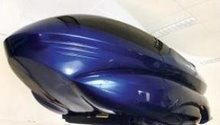
A third ion engine is now running on Japan's problem-plagued Hayabusa spacecraft. Having another working engine increases the chances that the spacecraft will be able to limp back to Earth.
If the craft does return as planned in 2010, researchers will finally find out whether it collected the first-ever samples from an asteroid during its two landings on the tiny space rock Itokawa.
watch an animated video of the mission
In late 2005, the spacecraft lost all the fuel for its chemical thrusters because of a leak, so mission managers have been trying to get Hayabusa home using its ion engines instead.
These engines ionise xenon gas and then use electric fields to accelerate the ions, providing a steady – though weak – thrust. They were meant to be used only for the outward journey to the asteroid.
Two of the four ion engines were tested in mid 2006 and found to be in working order, and Hayabusa began its return journey in April 2007. But these engines are in danger of failing – one of them has been firing for a total of 13,500 hours, close to its design lifetime of 14,000 hours.
Now, spacecraft operators have coaxed a third engine back to life. The engine started firing ions on 28 July after several days had been spent warming up the engine's power supply, a statement on the Japan Aerospace Exploration Agency (JAXA) website said.
This third engine has only been fired for 7,000 hours, leaving it with more expected lifetime than either of the others. The fourth engine is being reserved as a spare in case the others fail.
Hayabusa was meant to collect samples from Itokawa by firing pellets into the surface of the 535-metre-long rock and scooping up the resulting debris. But data from two landings in November 2005 suggest that the pellets never fired because the craft's onboard computer sent conflicting signals to its collection instruments.
Still, mission officials hope to bring the spacecraft back to Earth in case some asteroid dust slipped into its collection chamber by chance. If it completes the trip, it is expected to drop a capsule in the Australian outback in June 2010.
________________________________________________________
________________________________________________________
Mini-Mag Orion: A Near-Term Starship? from Centauri Dreams
________________________________________________________
________________________________________________________




1 comment:
Happy Blogday!
Post a Comment